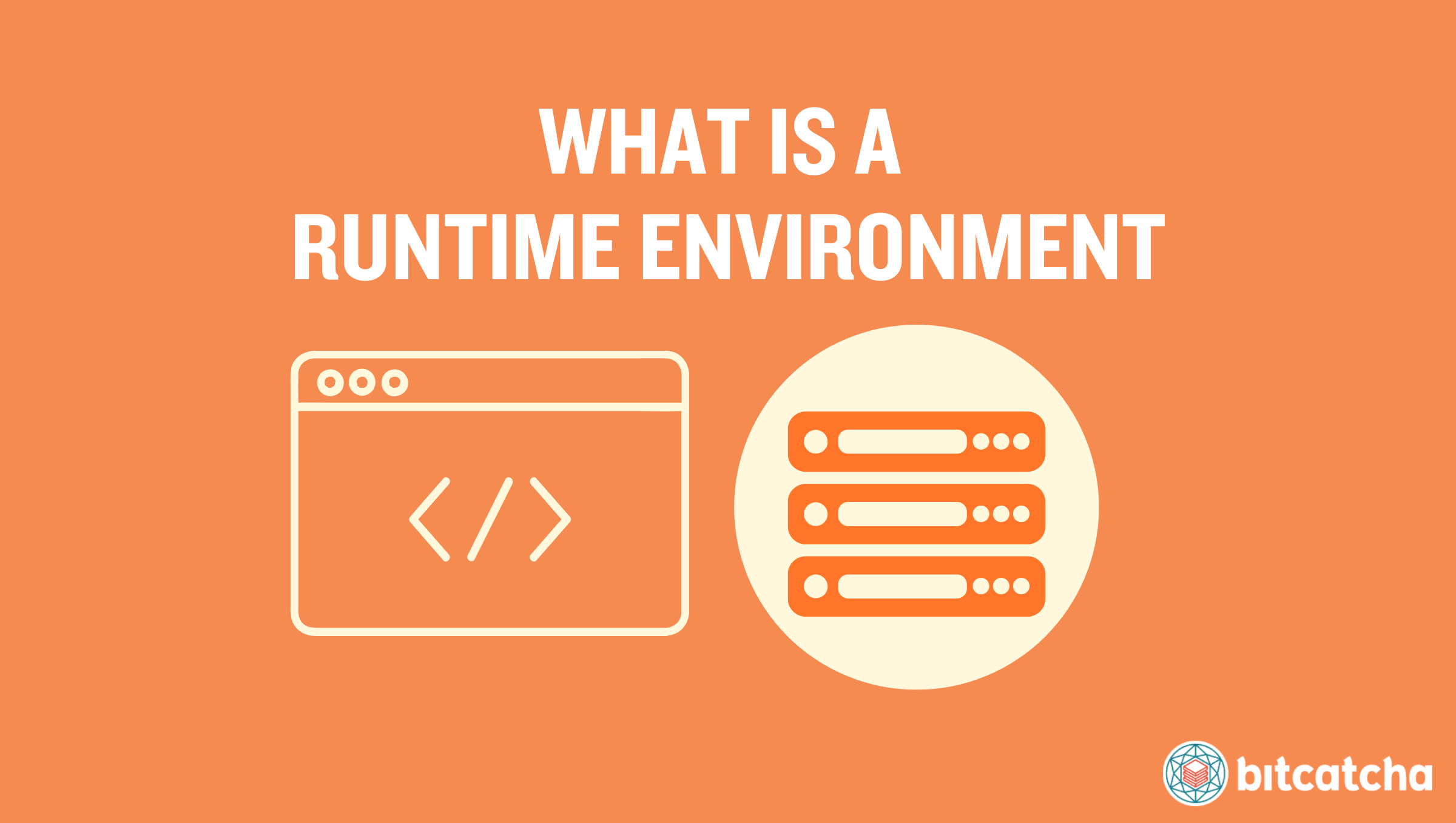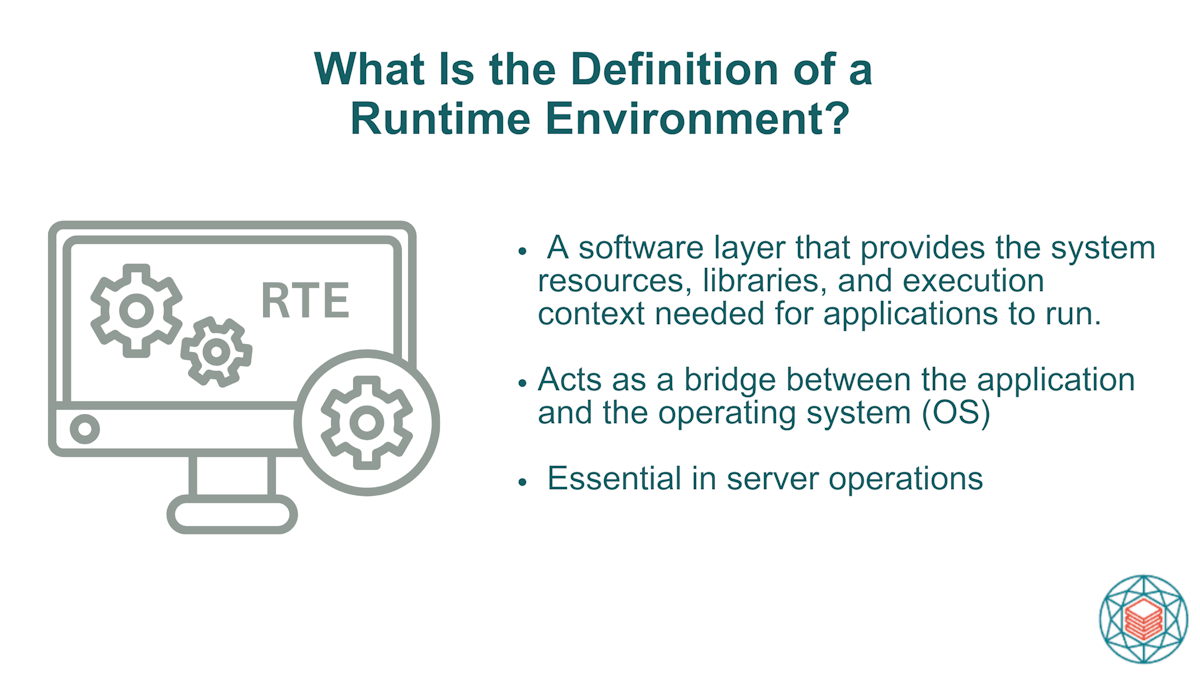A runtime environment (RTE) allows programs to execute correctly by providing the necessary environment and resources. There are 5 types of runtime environments: operating system, language-specific, browser-based, virtual, and containerized.
The purpose of a runtime environment is to ensure applications run reliably across systems without direct interaction with hardware. In web hosting, an RTE enables server-side applications to function efficiently by managing dependencies, allocating resources, and optimizing performance. To determine if a web host supports a specific runtime environment, it’s important to check hosting plan details, review documentation, or contact the host’s customer support. Web development also relies on runtime environments to execute and test code. Frontend applications use browser-based RTEs, while backend applications depend on language-specific RTEs such as Node.js for JavaScript or PHP runtime environments.

What Is the Definition of a Runtime Environment?
A runtime environment (RTE) is a software layer that provides the system resources, libraries, and execution context needed for applications to run. It acts as a bridge between the application and the operating system (OS) ensuring correct execution and dependency management. The term is also sometimes used to refer to the combined software and hardware framework that supports program execution.

RTEs are essential in server operations. They enable servers to run applications, manage resources efficiently, and maintain stability and performance. They also resolve dependencies, manage system interactions, and provide the infrastructure for server-side execution.
Important components of RTEs include an execution engine to process code, memory management to allocate and free resources, process management to schedule tasks, system libraries for essential functions, and security mechanisms to enforce access control and isolation. Certain RTE include runtime systems that handle garbage collection, threading, and function calls.
What Are the Different Types of Runtime Environment?

Different types of runtime environment refer to the different execution frameworks that enable software to run in specific contexts. There are 5 different types of runtime environment:
- Operating system Runtime Environment
- Language-specific Runtime Environment
- Browser-based Runtime Environment
- Virtual runtime Runtime Environment
- Containerized Runtime Environment
1. Operating System Runtime Environment
An operating system runtime environment provides the core system services necessary for software to execute on a specific operating system (OS). It acts as an interface between applications and the underlying OS, allowing software to run by directly managing hardware resources. Operating system runtime environments also handle APIs (Application Programming Interface), process management, memory allocation, and system calls.
In essence, the operating system itself serves as the fundamental runtime environment for all software executed on a computer. It lets applications interact with hardware, perform file operations, and execute networking tasks. Windows, Linux, and macOS provide built-in runtime environments that support applications designed for their platforms.
2. Language-Specific Runtime Environment
A language-specific runtime environment executes programs written in a particular programming language. It ensures that the code runs correctly across different platforms by managing execution, memory, and optimizations.
Examples of language-specific RTEs include the Java Virtual Machine (JVM) for Java, the Common Language Runtime (CLR) for .NET, and the CPython interpreter for Python.
3. Browser-Based Runtime Environment
A browser-based runtime environment enables JavaScript and other web scripts to execute within a web browser. It provides the necessary engine to process and run client-side scripts efficiently. These runtime environments allow dynamic web applications to function without requiring additional software installations. They enable interactive features such as animations, real-time updates, and API interactions. Examples of popular browser-based RTEs include V8 in Chrome, SpiderMonkey in Firefox, and WebKit in Safari.
4. Virtual Runtime Environment
A virtual runtime environment simulates an entire computer system, including its own operating system, on top of a host machine. This creates a fully isolated environment where applications run independently of the host OS. It allows multiple operating systems to run on a single physical machine.
Virtual runtime environments are useful for running multiple operating systems, testing applications, and enhancing security through deep isolation. They allow developers to replicate production environments and ensure consistency across different setups. Common virtual runtime environments include virtual machines (VMs) such as VMware and VirtualBox.
5. Containerized Runtime Environment
A containerized runtime environment encapsulates applications in lightweight, portable units called containers. These containers include all required dependencies, libraries, and configurations. Containerized runtime environments eliminate compatibility issues by isolating application execution and standardizing this execution across development, testing, and production environments.
This allows applications to run the same way regardless of the host operating system. A widely used example of a containerized runtime environment is Docker.
What Is the Purpose of a Runtime Environment?
The purpose of a runtime environment is to ensure applications run reliably across different systems without direct interaction with hardware. All software and services need runtime environments to work correctly. Runtime environments enable cross-platform compatibility, streamline resource management, and support efficient execution. They also allow developers to focus on writing code rather than handling low-level system operations.
4 common use cases of runtime environments are web development, web hosting, cross-platform applications, and cloud-based services.
What Is the Role of Runtime Environment in Web Hosting?
Web hosting refers to the provisioning of server resources that store, process, and deliver websites or web applications over the internet. The role of a runtime environment in web hosting is to provide the execution layer needed to run server-side applications. The RTE manages dependencies, ensures library compatibility, allocates system resources, and maintains consistent behavior across the web host’s servers.
Different web hosting types support different RTE configurations. Shared hosting typically offers pre-configured runtime environments that support common languages like PHP and Python. Cloud hosting supports custom runtimes for greater control and scalability. Developers who need precise runtime configurations benefit from developer-friendly hosting, which offers version control, advanced settings, and broad language support tailored for complex or language-specific projects.
How Do I Know If A Web Host Supports Certain Runtime Environment?
Determine if a web host supports a certain runtime environment by checking its hosting plan details, reviewing its documentation, or contacting customer support. Shared hosting providers typically list supported programming languages and frameworks on their feature pages, while cloud hosts specify compatible runtime environments and configuration options.
Linux hosting typically supports runtime environments for PHP, Python, and Node.js, while Windows hosting is required for .NET applications using the Common Language Runtime (CLR). Certain hosts offer cross-platform support, such as running Node.js on Windows. Since not all hosts support the same RTE, ensure you factor in software compatibility when in the process of choosing a web host.
Is a Runtime Environment Required for Developing a Website?
Yes, a runtime environment is required for developing a website. It enables developers to test and run their code locally before deploying it online. Without it, consistent testing, debugging, and deployment become difficult and time-consuming. Choosing the appropriate runtime environment is also crucial, as a mismatch between the chosen RTE and application leads to inefficiencies and compatibility issues
What Runtime Environment Is Needed For Web Development?
The runtime environment needed for web development depends on the type of development being performed. Frontend development requires a browser-based runtime environment to execute JavaScript and render web pages. Backend development relies on language-specific runtime environments such as Node.js or PHP. Local runtime environments, such as XAMPP for PHP or Python virtual environments, allow developers to simulate production conditions, debug errors, and test features before deployment.
